
34th America's Cup preview
The 34th America’s Cup sets sail today, with race one between the Larry Ellison-backed defender, Oracle Team USA, and the challenger, Emirates Team New Zealand, starting at 1315 local time (2015 UTC, 2115 BST). Two races are to be held each day with the competition continuing tomorrow, Tuesday and Thursday until the Kiwis hit nine wins or Oracle Team USA reach 11 (thanks to their two point penalty).
While at least from a year out, it was easy to predict how the Louis Vuitton Trophy would unfold: that Emirates Team New Zealand would come out on top among the challengers, Luna Rossa being too late and campaigning a first generation boat, while, despite having a gazillion PhDs in their employment, Artemis Racing was painfully slow to twig that getting your AC72 foiling was essential, the Swedish campaign then being dealt the cruel blow of Andrew Simpson’s loss. Finally with the America’s Cup match itself due to kick off imminently, we are pleased to report that we have finally come up against part of the competition where the outcome is hard to predict and we return to some sport, which has been sorely lacking from this event so far.
So who do we think is going to win? After much soul searching and contemplation – we think it will be Oracle Team USA. This is purely because we think their boat is faster and throughout the history of the America's Cup this has usually proved the winning factor. There are rumours of the Oracle AC72 having cruised above 50 knots while the Kiwi’s top speed during training is allegedly a fraction of a knot short of 50 knots (it is surprising how we talk so easily of these previously unimaginable speeds). However part of it could be weather dependent with the feeling that the Kiwis will prove dominant in stronger conditions, Oracle when its lighter.
Certainly some of this will be hyperbole, but as a rough trend we believe it to be true. The latest Oracle Team USA boat looks like it is a generation on from the second Emirates Team New Zealand boat, most ostensibly in the lengths to which the US team’s designers have gone to reduce windage – crucial to a degree you wouldn’t believe at the high speeds these boats sail at. For example a look at the rigging beneath the cross structure of the Oracle AC72 shows that they have a short D35-style flying centre hull aft of the main cross beam and then a cable running forwards with a dolphin striker/kingpost (or two, on their older boat) beneath the bowsprit. In comparison the Kiwi AC72 has a main dolphin striker/kingpost beneath the main beam with a similar cable set-up going forwards from this, and more cables heading aft instead of the ‘flying hull’ PLUS there two additional sets of stays going athwartships to the hull. The Oracle undercarriage looks exceeding clean in comparison.
Continuing the aero theme, both teams have gone big on fairings on their AC72’s two cross beams. The Kiwi boat also has a semi-circular fairing acting as an endplate for the bottom of her wing. On the Oracle boat this is quite different with a smaller rectangular area of ‘solid deck’ beneath the wing, however this extends forward of her main beam, forming a triangular section of ‘foredeck’ that acts as an endplate for her headsail. These configurations are partly born of the different structure between the two crossbeams on the two boats – on the Emirates Team New Zealand AC72 (like Luna Rossa) there are beams running from the wing step diagonally back to the aft beam to hull join on both sides. On the Oracle boats there are just two central fore and aft beams.
Obviously a lot may be hiding in the cross beam laminates, but in general terms it looks like the Oracle boats are lighter (always faster with multihulls – unless they break) but with a structure that probably moves around more, particularly in torsion. However as Moth sailors will tell you, any movement in the platform is generally bad on a foiler because it can affect the critical factor that is the pitch of the foil and this may be one of the factors contributing to why the Oracle boat doesn’t look as stable on her foils, with a slightly greater tendency to ‘dolphin’, than the Kiwi team’s boat.
Part of the pitching issue is also likely to be down to the difference in dihedral of the foils between the two boats (ie how much the lifting part of the foil is angled off the horizontal). Essentially the more dihedral, or ‘V’, that the boards have, the more stable the ride as it allows the ride height to self-adjust: when the boat is going slowly there is more ‘V’ is in the water and so more lift is generated. This elevates the boat out of the water, continually reducing the amount of the ‘V’ that is providing lift, until there is no longer enough and the boat drops back in the water. Following a cycle or two, eventually an equilibrium is reached.
However while a pure V-configuration foil makes for a comfy stable ride, its downside is drag.
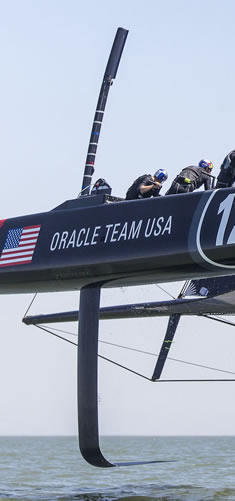 Looking at the two Cup boats, what this means is that Emirates Team New Zealand AC72 boards have more curvature at the top of their vertical component, so when they are lowered, the bottom of the boards naturally form more of a V shape. In contrast, the Oracle boards are more of a straight L-shape with less inherent dihedral and are therefore more difficult to control. It is thought that this may have been a contributing factor in Oracle’s capsize last year. However drawing absolute conclusions from this is hard as in addition to the boards’ inherent dihedral, on both boats additional dihedral can be artificially dialled in by canting the boards hydraulically (as well as being able to alter the pitch of the board, by inclining them fore or aft, which causes them to develop further vertical lift).
Looking at the two Cup boats, what this means is that Emirates Team New Zealand AC72 boards have more curvature at the top of their vertical component, so when they are lowered, the bottom of the boards naturally form more of a V shape. In contrast, the Oracle boards are more of a straight L-shape with less inherent dihedral and are therefore more difficult to control. It is thought that this may have been a contributing factor in Oracle’s capsize last year. However drawing absolute conclusions from this is hard as in addition to the boards’ inherent dihedral, on both boats additional dihedral can be artificially dialled in by canting the boards hydraulically (as well as being able to alter the pitch of the board, by inclining them fore or aft, which causes them to develop further vertical lift).
The stability of the ride is a vital part of the boat speed equation on the AC72s and an area where the Kiwis appear to have the upper hand. As proved time and again in the Louis Vuitton Cup, Luna Rossa would lose boatlengths whenever she ‘touched down’, while the Kiwis showed their usual meticulous skill in remaining airborne. This ability is obviously important both in a straight line, but particularly when turning corners – hence mastery of the foiling gybe has been important. Again let us remind ourselves what an accomplishment this represents – a 7 tonne catamaran foiling through a gybe... 10 years ago pioneering sailors were struggling to carry out foiling gybes successfully on their 30kg Moths...
So if Oracle generally has the faster boat, the Kiwis may well be able to recoup some of the difference by staying out of the water more consistently.
Upwind foiling seems to remain the ‘Wild West’ of AC72 sailing and possibly a red herring. The issue is not being able to do it, but being able to foil upwind without losing all of the considerable benefit of reducing parasitic drag (from the hull being no longer in the water) to colossal leeway. Hence why teams to date have been deliberately trying to keep their leeward hull firmly planted in the water (what the French call ‘Archimedian mode’) or else risk skating sideways (which in turn one imagines cannot be an overly good load situation for the foils). Foiling Moths overcome this sailing upwind by heavily canting the rig over to weather, moving the centre of effort of the rig as a windsurfer does, however this is the opposite of what happens when an AC72 goes upwind, flying a hull, when the wing's centre of effort drops to leeward. Effective upwind foiling will certainly be something to watch out for over the next few days.
Wisely, Grant Dalton warned earlier in the week to ‘be prepared for breakage’. AC72s are complicated boats to a degree we have never seen anywhere else, ever, in sailing and it only takes something small to go wrong for catastrophe to occur. A vital part of the development of these boats has been working through the risk list, planning for damage limitation and having a clear idea of what will put you out of the competition – hopefully nothing, as both teams have spare boats, wings and foils – or out of a race, a much longer list of potential threats. We suspect that Oracle Team USA’s boat being ‘lighter’ (we put this in inverted commas because the AC72 box rule specifies a displacement range of 5.7-5.9 tonnes – ie lighter than an ORMA 60) will be the more susceptible to damage, being structurally less stiff (we suspect) and having less miles on the clock.
Then there are the crews. On the one hand, Emirates Team New Zealand has not suffered a crippling capsize that caused them to lose months of training as was the case with Oracle. However on the other, this is the first occasion since the Louis Vuitton Cup was first introduced as a challenger series, that the challenger probably goes into the main event with less competitive racing under her belt than the defender, whereas Spithill and Ainslie have been mixing it up over the last few weeks in more or less identical boats.
While Kiwi skipper Dean Barker remains his unflappable self, into the mix is the psychological state of Oracle Team USA’s crew following the International Jury’s verdict over their cheating in the America’s Cup World Series that has caused them to go into this competition two points down and without their long term wing trimmer Dirk de Ridder. Certainly in the press conference Oracle Team USA skipper James Spithill didn’t appear to be his normal spritly self. Following the cheating accusations and the subsequent jury verdict, it would be all too easy for the Oracle team to fall apart from the inside instead of pulling together en masse to overcome the crisis. Historians will of course hark back to Dean Barker’s track record when he roundly beat Spithill (then with Luna Rossa) in the Louis Vuitton Cup semi-finals in 2007, but this isn’t really applicable six years on, particularly when there are one or two other ingredients vital to the mix.
Anyway, in a few hours time we will have a few more answers... We hope for the sake of the America’s Cup that it is a close fight.
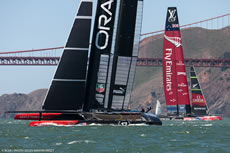 |
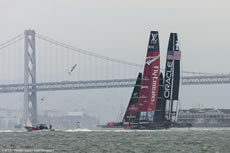 |
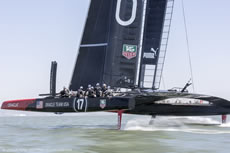 |
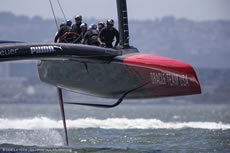 |
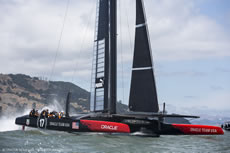 |
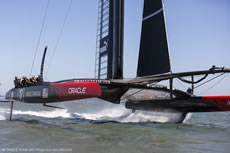 |
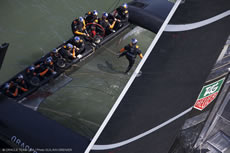 |
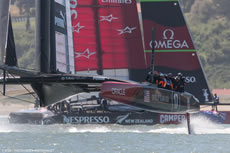 |
 |
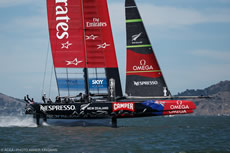 |
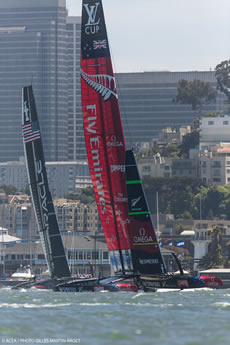 |
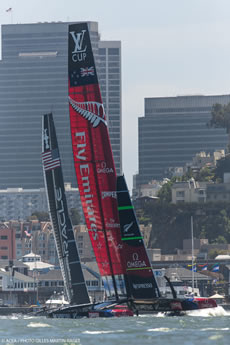 |

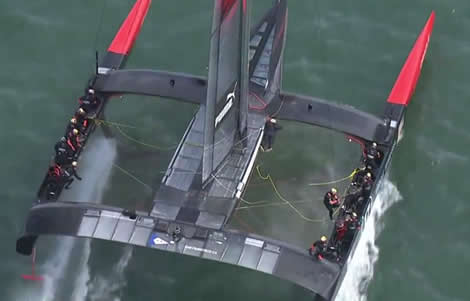
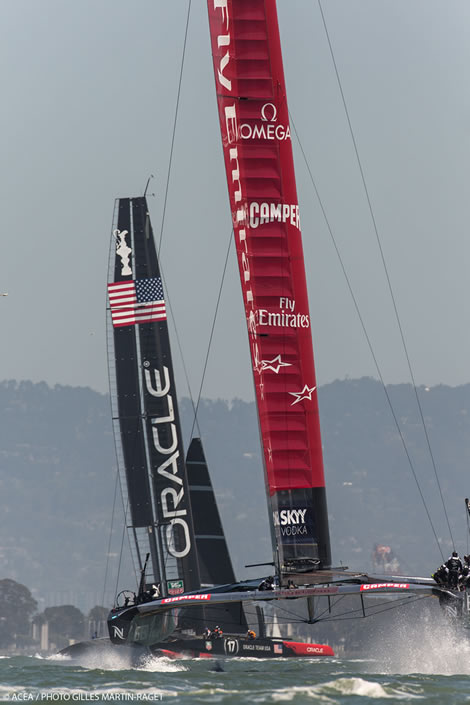







Latest Comments
Add a comment - Members log in